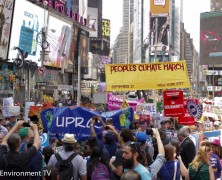In New York City, 300,000 to 400,000 people recently took to the streets calling for action on climate change. These concerned world citizens would be pleased to note that as we shift away from inefficient incandescent bulbs, those who choose LED lights are helping address climate change by minimizing humanity’s environmental impact. Electricity production is the single largest contributor to CO2 emissions, accounting for 38% of U.S. emissions from 1990-2012. LEDs help us address climate change by lowering our electricity demand and therefore lowering our CO2 emissions. While installing LED strip lights in your kitchen won’t stop global warming, if you choose to make the investment in LEDs, you’re doing your part to slow its progress. Here are the top environmental reasons for choosing LEDs over other conventional lighting sources: Energy Efficiency High quality LED lights work at 80% efficiency. That means that 80% of the electricity used by an LED chip goes straight into producing light. Compare that to an incandescent bulb, which in many cases is just 20% efficient — 80% of the electricity used is transferred into heat instead of light. The U.S. Energy Information Administration estimates that in 2012, lighting constituted 17% of the total energy used by homes and businesses in the United States. Switching our lights over to LEDs, making them use electricity with 80% more efficiency, would have a dramatic impact on our CO2 emissions. There are other cases where LEDs will come in handy as well, such as LED refrigerator display lighting and poultry farming, where we can further lower energy demands since cool LED running temperatures require less artificial cooling. Furthermore, LEDs produce directional light, meaning light isn’t wasted in directions where it isn’t needed. Less Waste The typical lifespan of an incandescent bulb is 750 to 1,000 hours. CFLs,...






